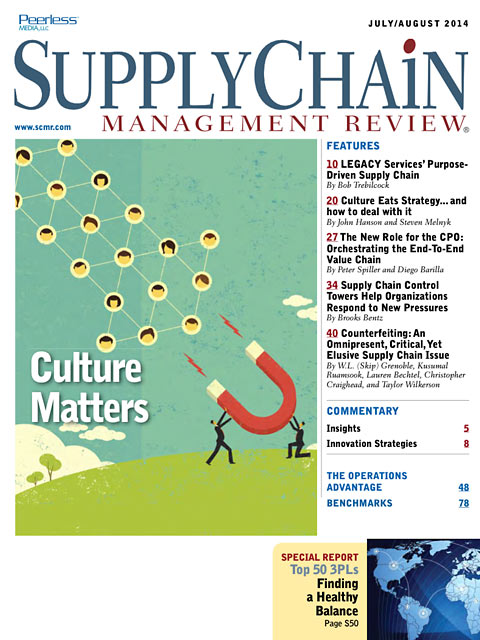Sorry, but your login has failed. Please recheck your login information and resubmit. If your subscription has expired, renew here.
July-August 2014
LEGACY Supply Chain Services has made company culture the centerpiece of how it drives innovation, efficiency, and the creation of value for its customers. Is it a model that others should replicate? Browse this issue archive.Need Help? Contact customer service 847-559-7581 More options
I admire UPS and FedEx for their parcel shipment innovations. They have clearly been two of our supply chain heroes; leaders in creating today’s impressive, renowned, and efficient parcel delivery industry. This industry has been a major player in enabling the e-commerce business to grow efficiently and rapidly over the past two decades.
Given the past Christmas season’s shipment delays, how did they (ironically) get positioned to become among the “Grinches That Stole Christmas” to parents and children that received gifts after Christmas Day—an unforgiveable sin in their eyes? Parents couldn’t blame themselves for being the last-minute shoppers they’ve always been when shopping at brick-and-mortar retail stores. When the last-minute shopper shopped at a store they could only blame themselves if the gift they wanted to buy was not on the shelf. In contrast, however, when they see a picture of the product on an Internet site, and the site says it’s available and can be delivered on time, if it’s then delivered late they blame the parcel carrier.
In the weeks following Christmas, pundits speculated as to the factors that led to the fiasco. These included: e-commerce orders that exceeded forecasts; an extended period of bad weather; too many last-minute shoppers; late-discounting by retailers to gin up business; a shortened holiday shopping season; the shifting of orders to air from ground due to retailer delays in processing orders; parcel carrier capacities that were exceeded; the insufficient supply of planes on the day before Christmas Eve; and lastly the parcel carriers’ executive leadership.
 |
This complete article is available to subscribers
only. Click on Log In Now at the top of this article for full access. Or, Start your PLUS+ subscription for instant access. |
Not ready to subscribe, but need this article?
Buy the complete article now. Only $20.00. Instant PDF Download.
Access the complete issue of Supply Chain Management Review magazine featuring
this article including every word, chart and table exactly as it appeared in the magazine.
SC
MR
Sorry, but your login has failed. Please recheck your login information and resubmit. If your subscription has expired, renew here.
July-August 2014
LEGACY Supply Chain Services has made company culture the centerpiece of how it drives innovation, efficiency, and the creation of value for its customers. Is it a model that others should replicate? Browse this issue archive. Access your online digital edition. Download a PDF file of the July-August 2014 issue. |
Download Article PDF |
I admire UPS and FedEx for their parcel shipment innovations. They have clearly been two of our supply chain heroes; leaders in creating today’s impressive, renowned, and efficient parcel delivery industry. This industry has been a major player in enabling the e-commerce business to grow efficiently and rapidly over the past two decades.
Given the past Christmas season’s shipment delays, how did they (ironically) get positioned to become among the “Grinches That Stole Christmas” to parents and children that received gifts after Christmas Day—an unforgiveable sin in their eyes? Parents couldn’t blame themselves for being the last-minute shoppers they’ve always been when shopping at brick-and-mortar retail stores. When the last-minute shopper shopped at a store they could only blame themselves if the gift they wanted to buy was not on the shelf. In contrast, however, when they see a picture of the product on an Internet site, and the site says it’s available and can be delivered on time, if it’s then delivered late they blame the parcel carrier.
In the weeks following Christmas, pundits speculated as to the factors that led to the fiasco. These included: e-commerce orders that exceeded forecasts; an extended period of bad weather; too many last-minute shoppers; late-discounting by retailers to gin up business; a shortened holiday shopping season; the shifting of orders to air from ground due to retailer delays in processing orders; parcel carrier capacities that were exceeded; the insufficient supply of planes on the day before Christmas Eve; and lastly the parcel carriers’ executive leadership.
 |
SUBSCRIBERS: Click here to download PDF of the full article. |
SC
MR

Latest Supply Chain News
- AI, virtual reality is bringing experiential learning into the modern age
- Humanoid robots’ place in an intralogistics smart robot strategy
- Tips for CIOs to overcome technology talent acquisition troubles
- There is still work to do to achieve supply chain stability
- Blooming success: The vital role of S&OE in nurturing global supply chains
- More News
Latest Resources

 Explore
Explore
Latest Supply Chain News
- AI, virtual reality is bringing experiential learning into the modern age
- Humanoid robots’ place in an intralogistics smart robot strategy
- Tips for CIOs to overcome technology talent acquisition troubles
- There is still work to do to achieve supply chain stability
- Blooming success: The vital role of S&OE in nurturing global supply chains
- Supply chain salaries, job satisfaction on the rise
- More latest news
Latest Resources

Subscribe

Supply Chain Management Review delivers the best industry content.

Editors’ Picks





